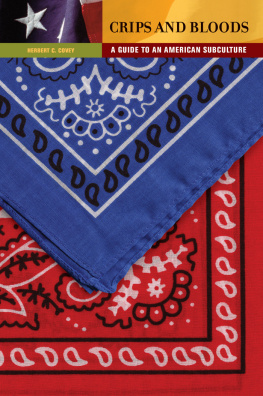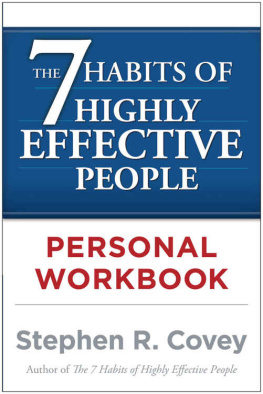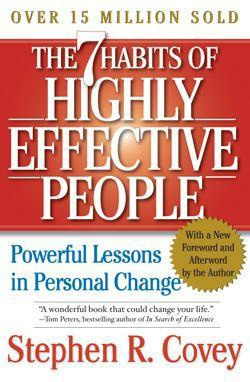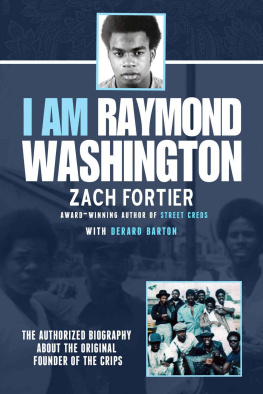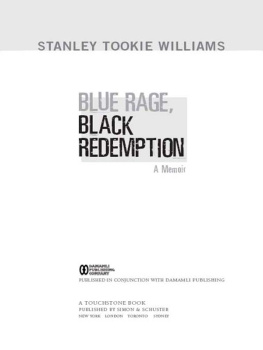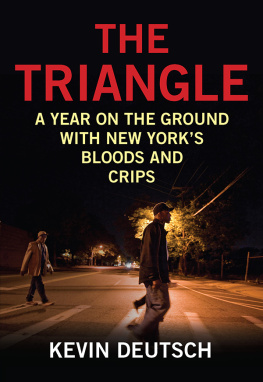Recent Titles in
Guides to Subcultures and Countercultures
The Ku Klux Klan: A Guide to an American Subculture
Martin Gitlin
Hippies: A Guide to an American Subculture
Micah L. Issitt
Punks: A Guide to an American Subculture
Sharon M. Hannon
Flappers: A Guide to an American Subculture
Kelly Boyer Sagert
Beatniks: A Guide to an American Subculture
Alan Bisbort
Goths: A Guide to an American Subculture
Micah L. Issitt
Radical Feminists: A Guide to an American Subculture
Paul D. Buchanan
Skinheads: A Guide to an American Subculture
Tiffini A. Travis and Perry Hardy
The Mafia: A Guide to an American Subculture
Nate Hendley
Guides to
Subcultures and
Countercultures | Crips and
Bloods A Guide to an American Subculture Herbert C. Covey |

Copyright 2015 by ABC-CLIO, LLC
All rights reserved. No part of this publication may be reproduced, stored in a retrieval system, or transmitted, in any form or by any means, electronic, mechanical, photocopying, recording, or otherwise, except for the inclusion of brief quotations in a review, without prior permission in writing from the publisher.
Library of Congress Cataloging-in-Publication Data
Covey, Herbert C.
Crips and Bloods : a guide to an American subculture/Herbert C. Covey.
pages cm. (Guides to subcultures and countercultures)
Includes bibliographical references and index.
ISBN 9780313399299 (hardback) ISBN 9780313399305 (ebook) 1. GangsUnited States. 2. Gang membersUnited States. 3. Juvenile delinquencyUnited States. 4. Street lifeUnited States. I. Title.
HV6439.U5C6782015
364.10660973dc232015002592
ISBN: 9780313399299
EISBN: 9780313399305
191817161512345
This book is also available on the World Wide Web as an eBook.
Visit www.abc-clio.com for details.
Greenwood
An Imprint of ABC-CLIO, LLC
ABC-CLIO, LLC
130 Cremona Drive, P.O. Box 1911
Santa Barbara, California 93116-1911
This book is printed on acid-free paper 
Manufactured in the United States of America
Contents
Series Foreword
From Beatniks to Flappers, Zoot Suiters to Punks, this series brings to life some of the most compelling countercultures in American history. Designed to offer a quick, in-depth examination and current perspective on each group, the series aims to stimulate the readers understanding of the richness of the American experience. Each book explores a countercultural group critical to American life and introduces the reader to its historical setting and precedents, the ways in which it was subversive or countercultural, and its significance and legacy in American history. Websters Ninth New Collegiate Dictionary defines counterculture as a culture with values and mores that run counter to those of established society. Although some of the groups covered can be described as primarily subcultural, they were targeted for inclusion because they have not existed in a vacuum. They have advocated for rules that methodically opposed mainstream culture, or lived by those ideals to the degree that it became impossible not to impact the society around them. They have left their marks, both positive and negative, on the fabric of American culture. Volumes cover such groups as Hippies and Beatniks, who impacted popular culture, literature, and art; the Eco-Socialists and Radical Feminists, who worked toward social and political change; and even groups such as the Ku Klux Klan, who left mostly scars.
A lively alternative to narrow historiography and scholarly monographs, each volume in the Subcultures and Countercultures series can be described as a library in a book, containing both essays and browsable reference materials, including primary documents, to enhance the research process and bring the content alive in a variety of ways. Written for students and general readers, each volume includes engaging illustrations, a timeline of critical events in the subculture, topical essays that illuminate aspects of the subculture, a glossary of subculture terms and slang, biographical sketches of the key players involved, and primary source excerptsincluding speeches, writings, articles, first-person accounts, memoirs, diaries, government reports, and court decisionsthat offer a contemporary perspective on each group. In addition, each volume includes an extensive bibliography of current recommended print and nonprint sources appropriate for further research.
Preface
I am a gang expertperiod. There are no other gang experts except participants.
Sanyika Shakur (aka Monster Kody Scott), Eight Tray Gangster
Over 25 years ago, I began a journey to better understand street gangs. Back then I was searching for a suitable book topic in crime and delinquency. As part of a book proposal, I discovered that very little academic work was available on street gangs, and much of what was available was outdated. In addition, I realized that scholars had made few attempts to summarize what was then known about youth gangs. Consequently, I invited two colleagues to join me and prepare a text on what was known about street gangs. Three book editions later and after a few joint publications, our friendship and working relationship remain intact. Soon after the first edition of the text, I would be appointed to the Colorado State Juvenile Parole Board, which resulted in my meeting numerous gang-involved youth over a 13-year span. The stories and comments of these gang-involved youth fueled my desire to understand more about their lives within and outside of their gangs. I never imagined that 25 years later I would still be involved with the topic of gangs.
Although gangs have been studied since the 1920s, the volume of literature was very limited until the past two decades. Today this is not the case, as many scholars, journalists, law enforcement agencies, and gang members have contributed to what we think we know about gangs. We know more today than ever before, yet there remains much to be learned. There remain several gaps in our understanding, and mysteries abound as to the true nature of gangs.
This volume tries to shed some light on Crip and Blood street gangs. These two gangs, more than any others, have shaped our perceptions of what street gangs are like throughout the world. However, as this volume will reveal, there are multiple and often contradictory observations and perceptions about both gangs. Scholars, law enforcement professionals, and gang members often have divergent views about both gangs. Part of this disagreement is because what represents a Blood or Crip gang can vary from one set to another and even among members. Apart from some language and subcultural commonalities, a Blood set in one community may have more in common with a Crip set in the same community than it does with other Bloods. Although many members from both gangs are generally committed to their sets and to being violent adversaries of rival gangs, at the end of the day they are more alike than different. From my experience on the parole board and extensive study, I reached the conclusion that youth involved in street gangs share similar backgrounds, hopes, dreams, and experiences as non-gang involved youth. This is not to say that there are no differences, as gang youth tend to offend more, are more likely to be victimized, and engage in negative behaviors, because of their involvement with gangs.
Next page
